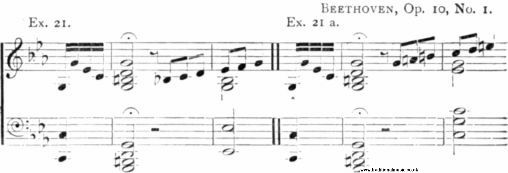MUSICAL MEMORY - online book
A System To Cultivate The Musical Memory For Musicians.
| Share page | Visit Us On FB |
|
26 |
MUSICAL MEMORY. |
||
 |
|||
|
Such passages may be regarded as the exception rather than the rule, and we admit they do not form the majority, but it is the obviousness of those cited rather than any essential difference which distinguishes them from many other passages like the following from Brahms' Rhapsody in B Minor, the security of which depends upon a recognition of the same principle:— |
|||
 |
|||
|
48. The "Methods" of Beethoven.—Not only, however, in the general design of movements which are built upon some clear and definite plan can we enlist the services of Intellectual memory, but it can be brought to our assistance also in the parts of movements which from their very nature are, to some extent irregular, as in the "development" of Sonata-form movements. Beethoven, beyond all other composers has shown how this portion of a movement, though quite free and unfettered in its progress, may yet be made in the highest sense coherent and satisfactory by the employment of various devices, which are valuable from an emotional point of view as they are intelligent from an intellectual one. To discuss the nature of such in any degree of detail belongs to a treatise on Musical Composition and not to a handbook on Musical Memory, but for the benefit of those who have not yet critically studied Beethoven's " methods," we will draw attention to a few of these devices, not regarding our reader as a student of composition, but as one who when playing from memory is desirous of making his performance secure by the co-operation of as many forms of memory as is possible, and who recognises that the perception of such devices adds to this security.
49. Perhaps the most prominent of such devices is a regular progression of the bass of the harmonic foundation, either descending or ascending. The descent of the bass in stepwise progression is illustrated at the beginning of the development of the first movement of the Sonata in G major, Op. 31, No. 1, and also in the development of the first movement of the |
|||